Plot summary
Barbary, a twelve-year-old girl, is an orphan who has lived in several group homes and foster families since the death of her mother. The novel opens with her waiting in a spaceport for a seat on a shuttle to Earth orbit, which will be the first step on a journey to the research space station Einstein, where she is to live with her new foster father, Yoshi, a poet and college friend of her mother's. Unfortunately, she has two difficulties: the shuttle is filled with dignitaries from Earth travelling to the station, so it's unlikely she will get a seat, and she is trying to smuggle her cat, Mickey, into space with her (pets are forbidden on the station).
Barbary gets a seat on the shuttle with the help of the station's new administrator, a famous African-American woman astronaut, who tells her the reason so many VIPs are on the shuttle: an alien spacecraft has entered the solar system. It is not responding to communications or making any transmissions, nor is it making any powered maneuvers, but its course will bring it close to Einstein.
Once she reaches orbit, Barbary spends several days on an orbital transfer ship before finally arriving at Einstein while managing to keep Mickey hidden. Once there, she meets Yoshi; Heather, her new sister, who is the first child born in space; and Thea, Yoshi's lover, an absent-minded astronomer. She hides Mickey in her and Heather's shared room, but has to reveal him to her fairly quickly. Heather agrees to help her keep Mickey hidden and fed while showing her around her new home and taking her on a trip outside the station in a vehicle called a "sled."
Barbary asks Heather if she knows any private places on the station where Mickey can move about more freely so he won't be bored. Heather shows them a radiation shielding sublevel of the station on the outer edge of its rotating ring; it is filled with dirt made from lunar regolith tailings from the station's construction. While there, Mickey crawls into a mistakenly-open access panel to an elevator shaft and the girls lose him. They are reunited when the station administrator later summons Barbary to the station control center, where Mickey has emerged, to the delight of the technicians. Initially the administrator wants to send Mickey back to Earth, but relents when a technician discovers a dead rat that Mickey has found and killed, proving he might be useful to the station as pest control.
In the meantime, Thea has been constructing a telescope instrument in the family's quarters which is to be put on a sled and sent toward the alien craft, which has finally made a course change to bring it near Einstein and has sent transmissions in many human languages. When Heather and Barbary are elsewhere on the station, Mickey climbs inside the instrument package, and is not noticed when the package is installed on the sled and sent off into space. Barbary figures out he is not on the station when the station computer tells her it can't detect the radio tracking tag on his collar. She and Heather take Heather's sled out and begin chasing after Mickey's sled, but when they catch up, both sleds are grabbed by tractor beams and pulled aboard the alien ship. The girls learn that the friendly aliens, which look like mobile crystalline columns, have been traveling through the galaxy for a billion years, and have come to the solar system to inform humanity of the rules of galactic society before humanity finds it first. The novel ends with the aliens beginning to take the girls back to their home.
Setting details
The future world of Barbary features a space infrastructure inspired by the work of Gerard K. O'Neill. Lunar material is mined on the Moon and sent into Earth orbit by mass driver, where it is used to construct space colonies. The situation on Earth, however, appears to be somewhat bleaker than that of the time of the novel's writing. It is mentioned that Barbary has never eaten beef and has almost been caught up in riots, that she has only ever seen animals like cows in zoos, that few people in cities keep pets any more, and that travel into the wilderness requires difficult-to-obtain permits.
In the novel we meet the Secretary-General of the United Nations, Ambassador Begay, a Navajo woman who was once leader of the "United Tribes of North America". However, Barbary also encounters "the vice-president" and "Secret Service" agents, presumably from a future United States, although this is not stated, nor what its relationship with the UTNA is. It is mentioned that the space settlements have representatives at the UN.
The novel contains many details about aspects of life in space and on the space station, especially on the effects of zero gravity and spin gravity.

The Space Shuttle program was the fourth human spaceflight program carried out by the U.S. National Aeronautics and Space Administration (NASA), which accomplished routine transportation for Earth-to-orbit crew and cargo from 1981 to 2011. Its official name, Space Transportation System (STS), was taken from a 1969 plan for a system of reusable spacecraft of which it was the only item funded for development. It flew 135 missions and carried 355 astronauts from 16 countries, many on multiple trips.

Between Planets is a juvenile science fiction novel by American writer Robert A. Heinlein, originally serialized in Blue Book magazine in 1951 as "Planets in Combat". It was published in hardcover that year by Scribner's as part of the Heinlein juveniles.

Kalpana Chawla was an Indian-born American astronaut and aerospace engineer who was the first woman of Indian origin to fly to space. She first flew on Space Shuttle Columbia in 1997 as a mission specialist and primary robotic arm operator.

Pamela Ann Melroy is an American retired United States Air Force officer and NASA astronaut serving as the deputy administrator of NASA. She served as pilot on Space Shuttle missions STS-92 and STS-112 and commanded mission STS-120 before leaving the agency in August 2009. After serving as deputy program manager of Space Exploration Initiatives with Lockheed Martin, Melroy joined the Federal Aviation Administration in 2011, where she was a senior technical advisor and director of field operations for the FAA's Office of Commercial Space Transportation.

Janice Elaine Voss was an American engineer and a NASA astronaut. Voss received her B.S. in engineering science from Purdue University, her M.S. in electrical engineering from MIT, and her PhD in aeronautics and astronautics from MIT. She flew in space five times, jointly holding the record for American women. Voss died in Arizona on February 6, 2012, from breast cancer.
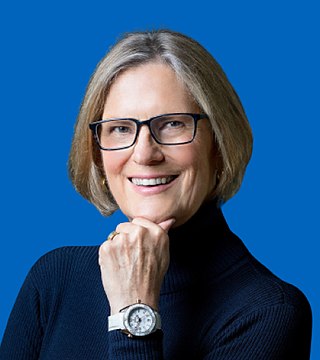
Kathryn Dwyer Sullivan is an American geologist, oceanographer, and former NASA astronaut and US Navy officer. She was a crew member on three Space Shuttle missions.
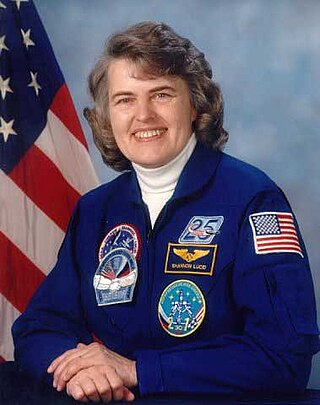
Shannon Matilda Wells Lucid is an American biochemist and retired NASA astronaut. She has flown in space five times, including a prolonged mission aboard the Russian space station Mir in 1996, and is the only American woman to have stayed on Mir. From 1996 to 2007, Lucid held the record for the longest duration spent in space by an American and by a woman. She was awarded the Congressional Space Medal of Honor in December 1996, making her the tenth person and the first woman to be accorded the honor.

Bonnie Jeanne Dunbar is an American engineer and retired NASA astronaut. She flew on five Space Shuttle missions between 1985 and 1998, including two dockings with the Mir space station.

The Space Transportation System (STS), also known internally to NASA as the Integrated Program Plan (IPP), was a proposed system of reusable crewed space vehicles envisioned in 1969 to support extended operations beyond the Apollo program.. The purpose of the system was two-fold: to reduce the cost of spaceflight by replacing the current method of launching capsules on expendable rockets with reusable spacecraft; and to support ambitious follow-on programs including permanent orbiting space stations around Earth and the Moon, and a human landing mission to Mars.

Ship of Fools is a science fiction novel by Richard Paul Russo. First published in 2001, it won the Philip K. Dick Award for that year.

Zenon: The Zequel is a 2001 Disney Channel Original Movie directed by Manny Coto in his last directorial film before his death in 2023. It is the second installment of the Disney Channel's Zenon television film series, following the first installment, Zenon: Girl of the 21st Century (1999), and preceding Zenon: Z3 (2004). The film is also the first sequel to be produced under the Disney Channel Original Movie banner. The Disney Channel Original Series Lizzie McGuire premiered after the film's premiere. This is the only Zenon film where Raven-Symoné doesn't play Nebula. She is replaced by Shadia Simmons.
The Alliance–Union universe is a fictional universe created by American writer C. J. Cherryh. It is the setting for a future history series extending from the 21st century into the far future.
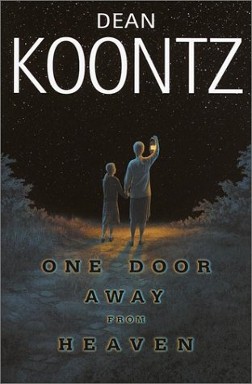
One Door Away From Heaven is a novel by the best-selling author Dean Koontz, released in 2001.
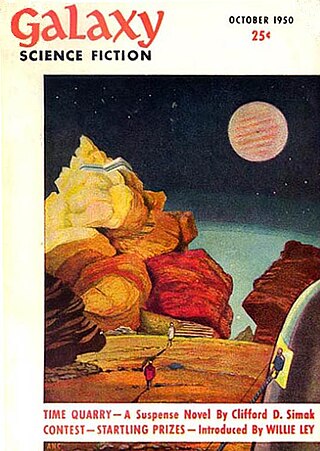
The planetary systems of stars other than the Sun and the Solar System are a staple element in many works of the science fiction genre.

Nicole Marie Passonno Stott is an American engineer and a retired NASA astronaut. She served as a flight engineer on ISS Expedition 20 and Expedition 21 and was a mission specialist on STS-128 and STS-133. After 27 years of working at NASA, the space agency announced her retirement effective June 1, 2015. She is married to Christopher Stott, a Manx-born American space entrepreneur.
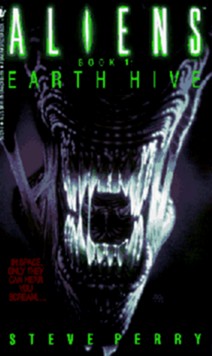
Aliens: Earth Hive is a 1992 novel by Steve Perry, set in the fictional Alien movie universe. It is an adaptation of the story "Outbreak" which was the first in the Aliens comic book series, written by Mark Verheiden.
Spaced Out is an animated series, co-produced by Alphanim Productions, Tooncan Productions and Cartoon Network Europe, in association with several other companies and television networks. The series had one season with 26 episodes.

A rocket sled launch, also known as ground-based launch assist, catapult launch assist, and sky-ramp launch, is a proposed method for launching space vehicles. With this concept the launch vehicle is supported by an eastward pointing rail or maglev track that goes up the side of a mountain while an externally applied force is used to accelerate the launch vehicle to a given velocity. Using an externally applied force for the initial acceleration reduces the propellant the launch vehicle needs to carry to reach orbit. This allows the launch vehicle to carry a larger payload and reduces the cost of getting to orbit. When the amount of velocity added to the launch vehicle by the ground accelerator becomes great enough, single-stage-to-orbit flight with a reusable launch vehicle becomes possible.

Alien: Out of the Shadows is a 2014 novel written by Tim Lebbon and published by Titan Books. Set between Alien and Aliens, the book chronicles Ellen Ripley's involvement in a Xenomorph outbreak on the planet LV-178 and the mining vessel in orbit above it. The survivors' attempts to escape the creatures are further complicated by Ash, whose A.I. consciousness has survived inside Narcissus, the shuttle that brought Ripley to them.

















